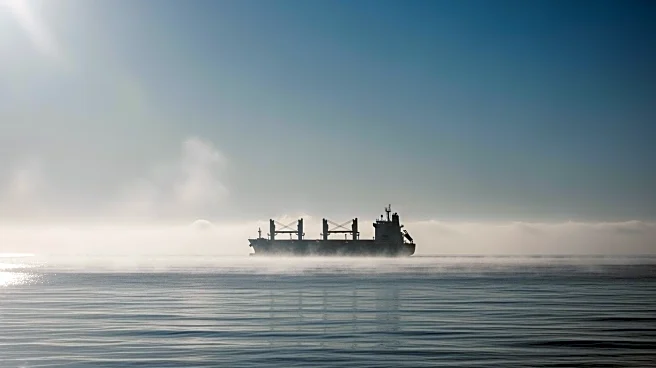What's Happening?
Recent research has highlighted that detectable ship tracks account for only 5% of aerosol indirect forcing (AIF) from ship emissions. The study utilized bottom-up and hybrid approaches to assess the impact
of ship emissions in the Southeast Atlantic shipping lane. It found that previous estimates significantly underestimated the influence of ship emissions due to the low detection rate of ship tracks and incorrect assumptions about their impact. The research combined cloud adjustments in liquid water path and cloud fraction with perturbations from top-down methods to better understand the discrepancy in the literature. The study also employed geospatial kriging to create counterfactual distributions of cloud properties, revealing that most of the forcing comes from the diffusion of aerosols that do not form readily detectable ship tracks.
Why It's Important?
This study is significant as it challenges previous assumptions about the environmental impact of ship emissions. By revealing that the majority of aerosol indirect forcing comes from non-visible ship tracks, it underscores the need for more comprehensive methods to assess the environmental impact of shipping. This has implications for environmental policy and regulation, particularly in the context of international shipping lanes. The findings could influence future strategies to mitigate the environmental impact of shipping, potentially leading to stricter regulations and the development of cleaner technologies. Stakeholders in the shipping industry, environmental advocacy groups, and policymakers may need to reconsider current practices and policies in light of these findings.
What's Next?
The study suggests that further research is needed to refine methods for assessing the environmental impact of ship emissions. This could involve developing more accurate detection techniques for ship tracks and improving models to predict aerosol indirect forcing. Policymakers may consider revising regulations based on these findings, potentially leading to stricter emission standards for ships. The shipping industry might need to invest in cleaner technologies and practices to reduce their environmental footprint. Additionally, international cooperation could be necessary to address the global impact of shipping emissions, as these findings have implications beyond the Southeast Atlantic region.
Beyond the Headlines
The study highlights the complexity of assessing environmental impacts and the importance of using multiple approaches to gain a comprehensive understanding. It also raises ethical considerations regarding the responsibility of the shipping industry to minimize its environmental impact. The findings could lead to long-term shifts in how environmental impacts are measured and regulated, potentially influencing other industries with similar challenges. This research may also contribute to broader discussions on climate change and the role of human activities in altering atmospheric conditions.











